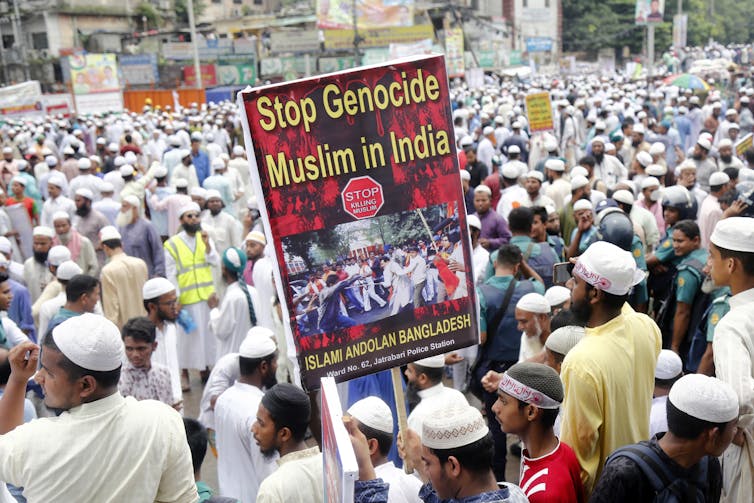If the pre-election polls are to be believed, India’s prime minister Narendra Modi, the leader of the Bhartiya Janata Party (BJP), is set to return to office for a third successive term when the result is declared on June 4. The election is the world’s largest and India has a very diverse population and complex culture, but Modi appears locked in to retain the power he has held on to since 2014.
Modi’s seemingly impenetrable popularity stems from a mix of his populist rhetoric, his affinity with India’s business elite, and his propagation of a Hindutva – Hindu nationalist – ideology. He is benefiting from India’s positive economic outlook – but there is also strong support in the country for Modi’s brand of populist autocracy.
Hindutva is an important part of this. This is a cultural nationalist ideology which portrays India as the “land of Hindus”, emphasising the need for unity among all Hindus across caste, linguistic, regional and class divides. Some adherents promote Hindutva as a way of countering what they see as the demographic, political and cultural threat posed by Muslims and Christians.
Under Modi’s premiership, Hindutva has been increasingly embedded into India’s social-legal-political system. On a national level, this has included the removal of statehood for Kashmir – previously India’s only Muslim-majority state.
There was also the implementation of the Citizenship Amendment Act, which prevents persecuted Muslims (but not other religious minorities including Christians) from neighbouring countries from claiming asylum in India.
At the state level, in BJP-run states, a slew of anti-conversion laws have been passed which seek to limit “conversion” to Christianity and Islam. Hindutva-aligned vigilante groups provide extrajudicial and often violent enforcement of these laws.
This has prompted a sharp rise in the number of everyday instances of anti-minority violence. The UN Special Rapporteur for Minority Issues, Fernand de Varennes, recently described this situation as “massive, systematic and dangerous”.
Voter turnout on the first two polling days of this election – April 19 and 27 – has been 66%, lower than expected. So it may have been to whip up voter passions that, in a recent campaign speech, Modi controversially referred to Muslims as “infiltrators” whose interests would be prioritised should his chief opponents, the Indian National Congress (INC) come to power.
It is unlikely that there will be any repercussions for this. If anything, Modi’s utterance could act as a dog-whistle and offer a cover for similar rhetoric to be used by local leaders across India’s states.
A question of geography
But this story of anti-minority rhetoric and violence in India is not linear and requires more nuance. The reality is that anti-minority rhetoric, while effective in many contexts across India, doesn’t always work for the BJP. In some ways it’s downright detrimental to the movement’s cause.
In fact, in certain states, the party has had to tone down its rhetoric and actively or reluctantly work to appeal to minority communities. India’s combined Muslim and Christian population consists of more than 200 million people scattered across the country and differentiated by caste, class, and practice. It would be folly to think that these communities could be homogeneous.
The BJP has traditionally found success in India’s Hindi-speakng heartland. Recently, it enjoyed electoral success in India’s north-eastern states but continues to struggle in most southern states. It is in these more linguistically and religiously diverse contexts that the Hindutva movement can be seen to tone down its homogeneous messaging to appeal to a broader public.

In the southern state of Kerala, Modi has made an effort to woo the state’s influential Christian community, which makes ups 20% of its population. This strategy centres around appealing to common dominant caste lineages of some of Kerala’s Christians and exploiting a shared anti-Muslim sentiment.
Similarly, in the northeastern state of Assam, the BJP has been trying to appeal to the state’s Muslims with promises of much-needed “development” initiatives in disadvantaged areas. The ruling party has reportedly been offering access to state resources for Muslim Dalits (the lowest or “Untouchable” caste) on the one hand while using scare tactics such as using bulldozers to knock down their houses if they do not vote for the BJP.
Modi and the BJP have a lot of catching up to do with Muslim voters after the controversial updating of the National Registry of Citizens in 2019. This was widely condemned as unfair to Muslims in its design and implementation, particularly Bengalis in the northeastern states of West Bengal, Tripura and Assam, who have historically been branded as illegal Bangladeshi immigrants.
Ideology and politics
India’s minorities have always been a significant factor in electoral politics as a vital source of votes. But exploiting these groups, often by using these communities as a threat designed to attract support from the Hindu majority has become a key strategy for the BJP under Modi’s leadership. Equally, Modi and the BJP – and the wider Hindutva movement – have recognised that sometimes it’s necessary to make ideological compromises for electoral gain.
So in this way, India’s diversity continues to be a hurdle to Hindutva’s homogenising project. While the ultimate goal of the movement is to establish India as a homogeneous Hindu state with Muslims and Christians as second-class citizens, these compromises serve as a reminder that the movement can be ideologically flexible to achieve its goals.
There are no signs that Indian people are becoming any less “religious”. So the continued political dominance of the BJP and social dominance of the Hindutva movement are likely to deepen religious divides – and minorities will continue being being pawns in the game of electoral politics.

